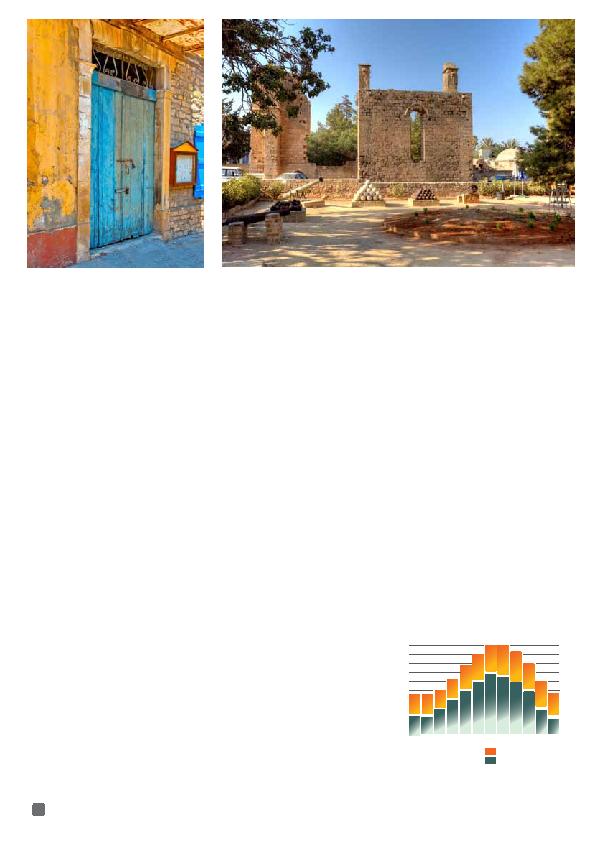
Food & Drink
The cuisine of Northern Cyprus owes its herit-
age to a mixture of Mediterranean and oriental
influences. Local dishes are good and made from
natural fresh produce. The `Meze' is a speciality of
Cyprus and consists of a large number of cold and
hot hors d'oeuvres such as different salads, meats,
vegetables and sea food, It is either taken as an
appetiser or as a main course. Other typical dishes
of the region are Shish Kebab (marinated lamb
skewered and grilled over charcoal). Yalanci Dolma
(wine leaves stuffed with rice onions and toma-
toes, Sheftali Kebab (spicy minced lamb wrapped
in skin and cooked on charcoal) Musakka (layers
of mince, potato aubergines and courgettes baked
in the oven with melted cheese topping). Typical
sweet desserts are Lokum (Turkish Delight). Bak-
lava (mille feuille pastry, nuts, honey and syrup),
Halva (flour, sugar, and ground sesame seeds).
Northern Cyprus produces a variety of local bran-
dies and the aniseed based `Raki' which is famous
in the region. These are the perfect accompani-
ment to the local dishes. European beer is also
produced locally under licence, Gold Fassl and
Altinada Pills are good local beers. In addition to
the local produce, restaurants and hotels offer a
wide range of wines, beers and spirits imported
from the Turkish mainland and Europe. Soft drinks
are widely produced and consumed locally. One
traditional way to finish your meal is a small cup
of Turkish Coffee.
Evening entertainment
Night life in Northern Cyprus is generally restricted
to a small number of nightclubs with a good selec-
tion of restaurants. There are good opportunities
for eating out from major hotel restaurants serv-
ing international dishes to small Bistro like restau-
rants, which offer typical Turkish-Cypriot cuisine
and is relatively cheap compared
with Southern Cyprus or Europe, Kyrenia Harbour
is an ideal place to dine in a picturesque surround-
ing, Many hotels and larger restaurants will stage
live music and/or local shows during the summer
season.
Language
Turkish is the official language of Northern Cyprus
and is fiendishly difficult for foreigners to become
proficient in but, fortunately. English is widely un-
derstood.
Passport & Visa
All visitors except Turkish citizens need a valid na-
tional passport for entry to Northern Cyprus, Brit-
ish Passport holders do not need a visa.
Climate
The climate of Northern Cyprus is typically Medi-
terranean. Summers (Jun to Sep) are hot and dry;
winters (Nov to Mar) are moderately rainy, with a
mild temperature. Spring and autumn are warm
and pleasant. The average annual temperature is
20 °C (68F). Summer temperatures average 30 °C
(90F) with the coldest months of Jan and Feb 10
°C (50F).
The island of Cyprus is located in the Eastern Med-
iterranean. Its nearest neighbour is Turkey, some
40 nautical miles north. To the east of the island
the mountain range loses height as it extends
along the narrow peninsula known as Karpas or
The Panhandle'. Along it one finds the best beach-
es in Cyprus. Miles of empty bays with pure white
sand, The resort town of Kyrenia is on the northern
coast, and the second resort town of Famagusta
in the east. Quite apart from the huge range of
cultivated flowers, Northern Cyprus and especially
the Karpas peninsula is a rich botanical area with
literally hundreds of species of wild flowers. From
February to June many areas of Northern Cyprus
are carpeted with colourful wild flowers. Wildlife
include birds, butterflies, lizards and the logger-
head and green turtle still come ashore to lay their
eggs on Northern Cyprus' unspoiled beaches.
Historical Outline
Archaeological excavations show settlements of
Neolithic Tribes from 7000 BC, which originated
from Anatolia and Mesopotamia. These early set-
tlers established small communities along the
coast. Although they used stone vessels they
were able to farm and domesticate animals. A
new wave of settlers who came after 6000 BC
brought pottery skills, the two sites excavated
from this age are at Vrysi in the north, 8 miles east
of Kyrenia, and Khirokitia half way between Limas-
sol and Nicosia which now remains on the south
of the border. Finds from these sites indicate a life
of farming, fishing, raising animals and weaving
wool. From 2000 BC onwards the island's strate-
gic location for trade and defence and its copper
resources, drew neighbouring powers to dominate
Cyprus one after the other, to the present day. This
has brought Cyprus a mosaic of cultural influences
and made the island a treasure chest of ancient
ruins, medieval castles and Abbeys.
Cyprus
A most hospitable welcome, with friendly people, beautiful natural attractions, unspolit
coastlines and historical interest of over nine thousand years.
68
North Cprus
Avarage montly
tempreture (°F)
80
70
60
50
40
Jan Feb Mar Apr May Jun Jul Aug Sep Oct Nov Dec
London
Call us for more information 0203 150 0352

